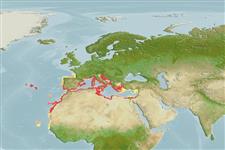Common names from other countries
Environment: milieu / climate zone / depth range / distribution range
Ecologie
; diepteverspreiding 4 - 100 m (Ref. 4). Subtropical, preferred 20°C (Ref. 107945); 46°N - 13°N, 32°W - 36°E (Ref. 4)
Eastern Atlantic and the Mediterranean: from Lisbon, Portugal to Senegal, and the Mediterranean.
Length at first maturity / Size / Gewicht / Leeftijd
Maturity: Lm ? range ? - ? cm Max length : 45.0 cm TL mannelijk/geslacht niet bekend; (Ref. 4); common length : 36.0 cm TL mannelijk/geslacht niet bekend; (Ref. 441)
Carapace length: 12 cm. Occurs at depths between 4 and 100 m on rocky or sandy substrate. Feeds on mollusks, especially limpets (Patella sp.). Ovigerous females are observed from June to August (Ref. 4).
Life cycle and mating behavior
Geslachtsrijpheid | Voortplanting | Kuitschieten | Eieren | Fecundity | Larven
Ovigerous females from June to August (Ref. 4).
Holthuis, L.B. 1991. (Ref. 4)
Status op de Rode Lijst van het IUCN (Ref. 130435)
Status bij CITES (Ref. 108899)
Not Evaluated
Not Evaluated
Gebruik door de mens
Visserij: commercieel
FAO - Visserij: landings | FishSource | Sea Around Us
Tools
Internet-bronnen
Estimates based on models
Preferred temperature
(Ref.
115969): 14.6 - 21.6, mean 18.7 (based on 246 cells).
Weerstandsvermogen
Gemiddeld, minimale populatieverdubbelingstijd 1,4-4,4 jaar (K=0.2).
Kwetsbaarheid
Low to moderate vulnerability (35 of 100).
